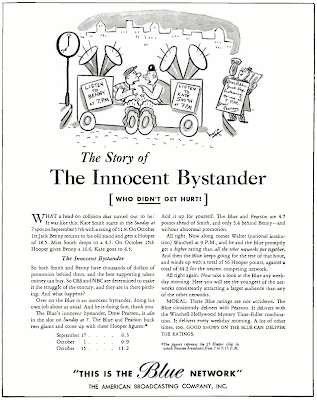“How could you do this to us?” is how viewers collectively reacted. Quickly, the quiz shows were cancelled. Even quicker, politicians took advantage of the scandal to put on their own big shows with a grand jury and a congressional hearing.
The scandal seems to have tarnished everyone associated with the rigged programmes. Who knew the fix was in and who didn’t? Caught in the middle were the hosts of the shows, who suddenly found themselves pariahs after their games were taken off the air. At least for a time. Even Jack Barry was able to resurrect his game show career, and partnered again with ex co-producer Dan Enright, the man responsible for making “Twenty One” as phoney as a twenty-one dollar bill.
This wire service story is self-explanatory and appeared in newspapers on December 13, 1959, about six weeks after Charles Van Doren’s sudden confession to a U.S. Congressional committee that he had been a willing party to deceive viewers of “Twenty One.”
Those TV Quizmasters
Where Have They Gone?
EDITOR’S NOTE: During the recent television rigging scandals, quiz shows almost overnight went from ask to axed. And so did the glib, glamorous quizmasters. How are they faring today? An Associated Press writer tracks them down for their unrehearsed replies.
By CYNTHIA LOWRY
Associated Press Writer
New York—Where have they gone and what are they doing now, those bright, ebullient and efficient quizmasters who posed the questions, rang the bells and gentled down the presumably nervous contestants?
There are just about as many answers as there are quondam quizmasters.
Jack Barry, late of Twenty-One, is dividing his time among several enterprises in which he has financial interests, particularly a company concerned with “scented advertising.” He is executive vice-president.
“We’re interested in impregnating newspapers, magazines, even plastic bags with scent,” explains Barry, “and in the general use of aroma as another advertising medium.”
He was out all summer in stock with a new comedy of which he was both producer and star. He expects to continue working in nightclubs. “I’m off the air—television—at the moment as a performer,” says Barry. “I’ve had 20 years as an emcee, and I’m off because there are no inquiries about me. But I expect to be back in TV—sometime.”
Jack Narz, a quizmaster who had double trouble, is sitting out a contract with a soap company. But he has heard some troubling news “by the grapevine.”
Narz was brought to New York from the West Coast to take over Dotto, the first show to collapse from rigging charges. Then he moved over to “Top Dollar,” which was banished by network edict.
“There have been opportunities—we’ve heard about several shows,” says Narz, “but I've heard that they worry about taking me on a show because some of the quiz mess is hanging over me like a cloud. I don’t think so—at least I haven’t had a single letter in which, I was blamed by a viewer.”
His contract with a former sponsor runs out at the first of the year. Meanwhile he’s biding his time, staying home with his family in suburban Mamaroneck, and hoping another emcee job will come through.
If it doesn’t he may go back to doing commercials, or perhaps to the sort of chores he performed before quiz shows—working with Ernie Ford and Bob Crosby on their shows, and taking over during vacations.
“My problem is trying to convince the trade,” he says, “that the public doesn’t blame me. Anyway, I know this situation won’t last.”
 Hal March of The $64,000 Question, is touring in the national company of “Two for the Seesaw.” March was interested in returning to acting long before the TV show was canceled by the sponsor, and even asked for release from his contract.
Hal March of The $64,000 Question, is touring in the national company of “Two for the Seesaw.” March was interested in returning to acting long before the TV show was canceled by the sponsor, and even asked for release from his contract.Ralph Story, last quizmaster of the $64,000 Challenge, has made a couple of panel show pilot films, is doing some work on the West Coast, and appeared briefly recently in a commercial on The Big Party.
Randy Merriman, once on The Big Payoff, quit the show to return to TV and radio work in Minneapolis. Bob Paige, who succeeded him, is returning to California for motion picture and TV work—and is reported to have an interest in some oil wells.
Bert Parks took over The Big Payoff three weeks before it was dropped and now is host on Masquerade Party, a games show which replaced Name That Tune.
George DeWitt, who presided over Name That Tune, for such a long time, is frankly pleased to be out from under. He has been trying out for host jobs on proposed TV shows—one a revival of Songs for Sale—and has several nightclub bookings.
“I want to spend a lot of time in Florida,” he says. “I’ve had to fly back and forth from Florida every week, and now I can go fishing. I also can play nightclubs for more than a couple of nights at a time. I’m sort of happy about the whole thing—I had a bad contract that I’m glad to get rid of and anyway, I’d like to do something different.”
Bill Nimmo of For Love or Money, has been busy doing commercials; Sonny Fox, once of $64,000 Challenge, has his own show on an independent New York station; Bill Wendell, late of Tic Tac Dough, is back as a staff announcer at NBC.









.png)
.png)
.png)
.png)
.png)



.png)
.png)
.png)
.png)
.png)
.png)
.png)

.png)
.png)
.png)
.png)
.png)
.png)